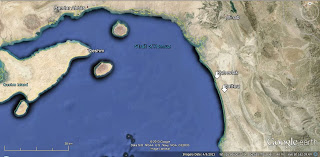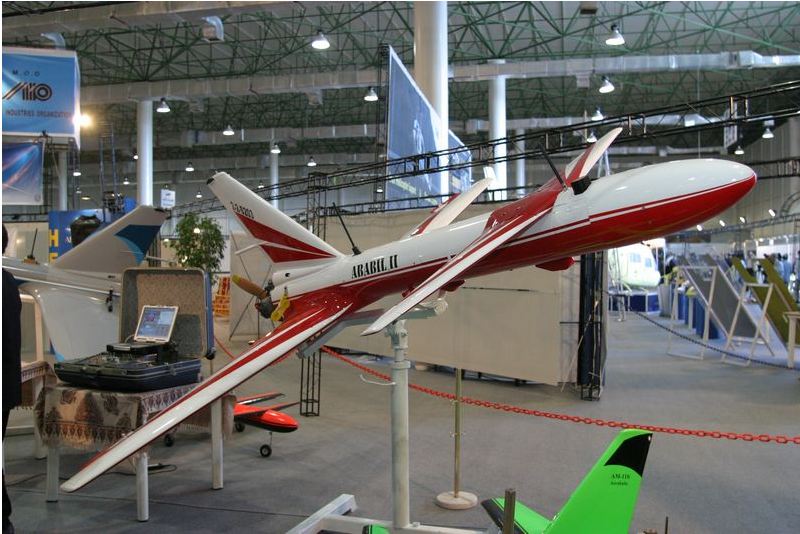Kuhestak Coastal Missile Battery
On 'Navy Day 2013', the IRIN commander - Admiral Sayyari - noted that the service was continuing to develop their infrastructure along the country's south-eastern coast, including the expansion of ports at Sirik, Jask, Kuhestak, Konarak, and Pasabandar. [1] Although the current IRIN construction is absent from currently available IMINT, one of these locations - Kuhestak - is already host to a legacy ASCM battery dating from height of the Tanker War.
In the mid/late-1980s, attacks on commercial shipping in the Persian Gulf began to heat up, first as Iraq sought to slow Iran's ground offensives, and then as Iran sought to retaliate in kind. For their part, Tehran found themselves relying on lightweight air and surface-launched weapons that limited their ability to project power. To remedy this, Tehran attempted to procure more potent weapons like the HY-2 anti-ship cruise missile (ASCM). The first examples were captured from Iraqi positions on the Faw peninsula in February 1986 during the Valfajr-8 offensive, which were then supplemented afterward by direct deliveries from China. [2]
To field these new systems, both the IRIN and the IRGCN began constructing a number of coastal garrisons, including a hardened battery near the town of of Kuhestak at the mouth of the Persian Gulf. By July 1987, Washigton noted the operational deployment of HY-2s at Kuhestak. [3] A year later, as US-Iranian confrontation continued to escalate, the underground-facilities at Kuhestak were near completion. To Washington, this battery posed a unique threat because - unlike the facilities at Abu Musa or elsewhere - the underground facilities at Kuhestak allowed Iranian forces to conceal the otherwise time-consuming launch-preparation from airborne sensors, increasing their chances at carrying out a surprise attack. To counter this threat, Washington ordered the deployment of the Aegis-cruiser, the USS Vincennes. [4]
Although the Vincennes ultimately played a key role in Iran's acceptance of the 1988 ceasefire - the downing of a civilian-airliner was instrumental in convincing Tehran that the regional and global balance of power had turned against it - it was never called to defend against the cruise-missile threat. Tehran's decision not to escalate the confrontation in this manner was due in large part to the red-line drawn by Washington, which deterred Tehran from ordering the use of HY-2s in the southern Gulf.
25 years later, the hardened facilities at Kuhestak remain, though it is unclear whether they are maintained, let alone hosting an active garrison. As Iran's naval forces have replaced their HY-2s with container-launched missiles in self-contained, mobile platforms, there is a decreasing need for these static bases with overhead cover and concealment. However, given that the HY-2 can still be seen on exercises, being fired from pre-established launch zones, it's not beyond the realm of possibility.
Located about 8 km south of the town of Kuhestak, the battery is dug into a small stretch of hills running along the coast. Split into three distinct sections, the battery includes two firing sections, a target-acquisition section, and a support section. Google Earth offers imagery of the base from 09/2012, 10/2012, 12/2012, and 01/2013.
The two firing sections are located side-by-side, and each feature facilities for two launchers, including concrete ramps leading from hardened shelters to firing pads, providing a place to fuel and prepare alert missiles. Each section has three-four additional hardened shelters set back from the firing-positions, which likely hold missile reloads.
On top of the adjacent hill is a cluster of hardened shelters that is likely associated with the battery's target acquisition section. This position would have offered the best vantage point for the section's target acquisition radar observed by USN forces in 1987. One probable location for the radar is a revetted pad similar to those used for radars in air-defense batteries.
Beyond these distinction sections, there are at least two more hardened shelters found elsewhere in the compound. In the shadow of several smaller hills are the batteries support facilities, including living quarters for the weapon crews. In addition, a handful (at least seven) of small concrete pads - typically associated with Zu-23-2 AAA - dot the compound.
The available evidence suggests a limited operational capability. The air-defense pads are empty, and overgrown foliage can be seen on the alert ramps. However, in 01/2013, one small wheeled vehicle can be seen in front of one of the firing-section's hardened shelters. This is the only evidence of activity across the range of imagery.
References:
In the mid/late-1980s, attacks on commercial shipping in the Persian Gulf began to heat up, first as Iraq sought to slow Iran's ground offensives, and then as Iran sought to retaliate in kind. For their part, Tehran found themselves relying on lightweight air and surface-launched weapons that limited their ability to project power. To remedy this, Tehran attempted to procure more potent weapons like the HY-2 anti-ship cruise missile (ASCM). The first examples were captured from Iraqi positions on the Faw peninsula in February 1986 during the Valfajr-8 offensive, which were then supplemented afterward by direct deliveries from China. [2]
To field these new systems, both the IRIN and the IRGCN began constructing a number of coastal garrisons, including a hardened battery near the town of of Kuhestak at the mouth of the Persian Gulf. By July 1987, Washigton noted the operational deployment of HY-2s at Kuhestak. [3] A year later, as US-Iranian confrontation continued to escalate, the underground-facilities at Kuhestak were near completion. To Washington, this battery posed a unique threat because - unlike the facilities at Abu Musa or elsewhere - the underground facilities at Kuhestak allowed Iranian forces to conceal the otherwise time-consuming launch-preparation from airborne sensors, increasing their chances at carrying out a surprise attack. To counter this threat, Washington ordered the deployment of the Aegis-cruiser, the USS Vincennes. [4]
Although the Vincennes ultimately played a key role in Iran's acceptance of the 1988 ceasefire - the downing of a civilian-airliner was instrumental in convincing Tehran that the regional and global balance of power had turned against it - it was never called to defend against the cruise-missile threat. Tehran's decision not to escalate the confrontation in this manner was due in large part to the red-line drawn by Washington, which deterred Tehran from ordering the use of HY-2s in the southern Gulf.
25 years later, the hardened facilities at Kuhestak remain, though it is unclear whether they are maintained, let alone hosting an active garrison. As Iran's naval forces have replaced their HY-2s with container-launched missiles in self-contained, mobile platforms, there is a decreasing need for these static bases with overhead cover and concealment. However, given that the HY-2 can still be seen on exercises, being fired from pre-established launch zones, it's not beyond the realm of possibility.
Located about 8 km south of the town of Kuhestak, the battery is dug into a small stretch of hills running along the coast. Split into three distinct sections, the battery includes two firing sections, a target-acquisition section, and a support section. Google Earth offers imagery of the base from 09/2012, 10/2012, 12/2012, and 01/2013.
The two firing sections are located side-by-side, and each feature facilities for two launchers, including concrete ramps leading from hardened shelters to firing pads, providing a place to fuel and prepare alert missiles. Each section has three-four additional hardened shelters set back from the firing-positions, which likely hold missile reloads.
On top of the adjacent hill is a cluster of hardened shelters that is likely associated with the battery's target acquisition section. This position would have offered the best vantage point for the section's target acquisition radar observed by USN forces in 1987. One probable location for the radar is a revetted pad similar to those used for radars in air-defense batteries.
Beyond these distinction sections, there are at least two more hardened shelters found elsewhere in the compound. In the shadow of several smaller hills are the batteries support facilities, including living quarters for the weapon crews. In addition, a handful (at least seven) of small concrete pads - typically associated with Zu-23-2 AAA - dot the compound.
The available evidence suggests a limited operational capability. The air-defense pads are empty, and overgrown foliage can be seen on the alert ramps. However, in 01/2013, one small wheeled vehicle can be seen in front of one of the firing-section's hardened shelters. This is the only evidence of activity across the range of imagery.
References:
[1] Interview with Admiral Sayyari / 'Kuhestak'; newest naval base. Tasnim News. 12/02/13 http://www.fardanews.com/fa/news/306469/%DA%A9%D9%88%D9%87%D8%B3%D8%AA%DA%A9-%D8%AC%D8%AF%DB%8C%D8%AF%D8%AA%D8%B1%DB%8C%D9%86-%D9%BE%D8%A7%DB%8C%DA%AF%D8%A7%D9%87-%D8%AF%D8%B1%DB%8C%D8%A7%DB%8C%DB%8C-%D8%A7%D8%B1%D8%AA%D8%B4
[2] Tom Cooper and Farzad Bishop. The Iran-Iraq War in the Air. 2000. p.197-198, 250-253
[3] US warplanes flight, Iranian missile deployment coincidental, sources say. AP. 06/06/87
http://www.apnewsarchive.com/1987/US-Warplanes-Flight-Iranian-Missile-Deployment-Coincidental-Sources-Say/id-02d19642ad43bcf70ffa8b24867b2dd7
[4] Iran said to fortify key strait. NYT. 06/01/88 http://www.nytimes.com/1988/07/01/world/iran-said-to-fortify-key-strait.html





Comments
Post a Comment